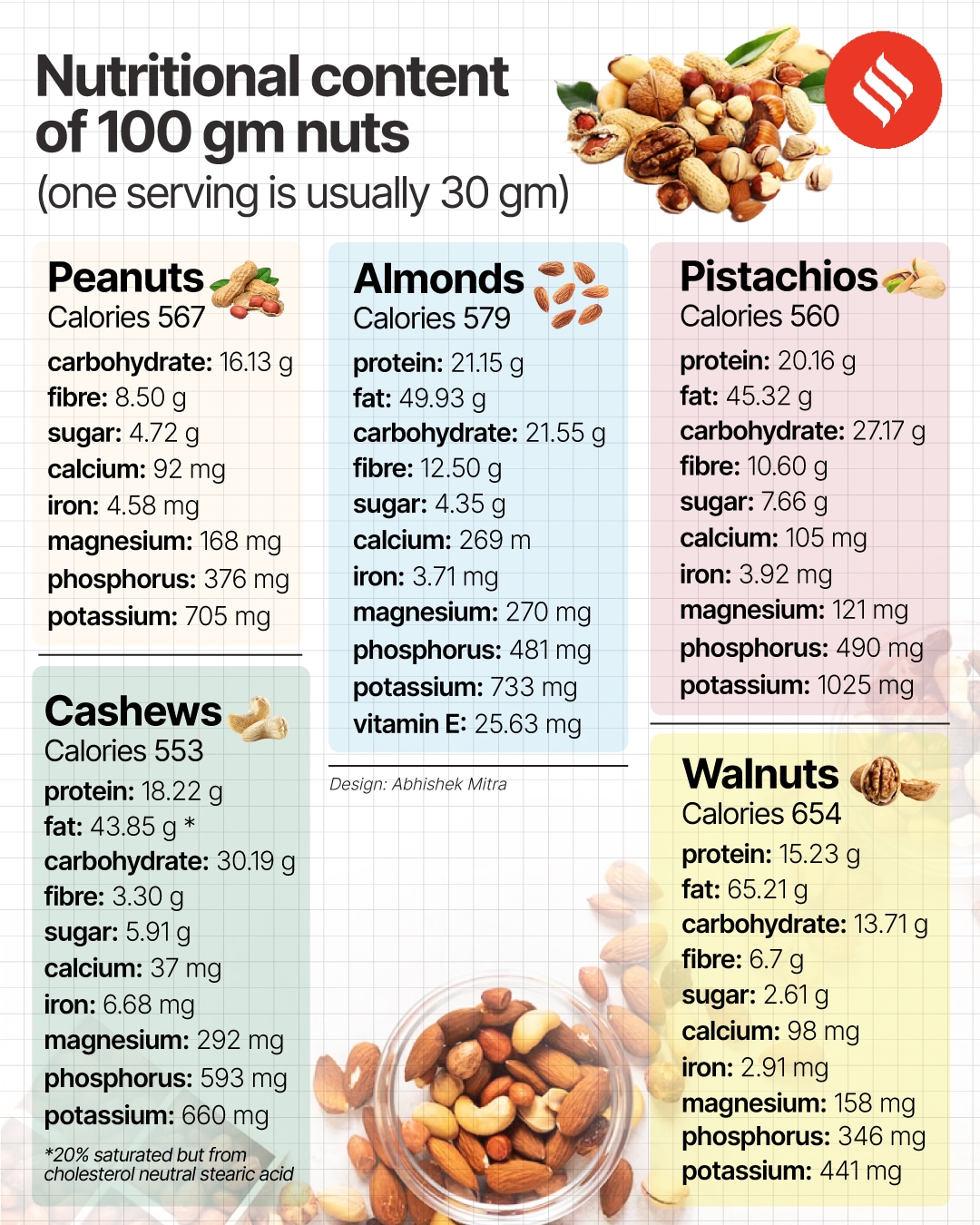Why almonds and walnuts are safest nuts for diabetics: Just a serving is enough
Due to their high protein and fibre content, nuts like almonds and walnuts have a low glycemic index. So they don’t cause sharp spikes in blood glucose and may slow down its release when taken with carbohydrate-rich meals. They provide satiety and tame hunger pangs, says Dr Ambrish Mithal, Chairman of Endocrinology and Diabetes, Max Healthcare
 Take a look at these! (Source: Getty Images/Thinkstock)
Take a look at these! (Source: Getty Images/Thinkstock) Can you guess one food group which is high in protein, “good” fats, antioxidants and fibre? And has been shown to be good for controlling diabetes and heart health? The answer is “nuts.” A useful snack with all these properties, are all nuts the same and can you have as many nuts as you like? Let’s try to find some answers.
What are nuts?
Tree nuts are dry fruits with one seed in which the ovary wall becomes hard at maturity. The most popular edible tree nuts in India are almonds, cashews, walnuts and pistachios. Peanuts, which actually are groundnuts or legumes, are widely identified as part of the nut food group and have a similar nutrient profile to tree nuts. Nuts have long been a part of human diets, appreciated for their taste, flavour and crunchy texture.
Nutritional Properties of Nuts
Fats: Nuts are rich in monounsaturated and polyunsaturated fats, including Omega-3 and Omega-6 fatty acids. These fats play a vital role in heart health, reducing LDL cholesterol levels and lowering the risk of cardiovascular diseases. They have a high total fat content, ranging from 46 per cent in cashews and pistachios to 76 per cent in macadamia nuts. Walnuts are a vegetarian source of Omega-3 fats, the kind found in flax, hemp and chia seeds.
Proteins: One of the challenges vegetarians face is getting adequate protein from their diet. Nuts are an excellent vegetarian source of protein. One serving is just a handful (30 gms) and contains 6-7 grams of protein, which is equivalent to that provided by one egg or one medium (250 ml) glass of milk. Proteins are essential for our growth and development, muscle strength, cellular repair and numerous other bodily functions.
Fibre: Nuts have generous amounts of dietary fibre, which aids in digestion, regulates blood sugar levels and promotes satiety. A high-fibre diet has been linked to a reduced risk of obesity, diabetes and certain types of cancer. One serving (30 gm) usually contains 3-4 gm of fibre.
Vitamins and Minerals: Nuts are a source of vitamins and minerals, including vitamin E, magnesium, phosphorus and potassium. Vitamin E acts as an antioxidant, protecting cells from oxidative damage, while minerals are crucial for maintaining healthy bones, muscles and nerve function.
Calories: Because of their fat content, nuts are high in calories, which is why the recommended portion size is a small handful (30 g). This quantity of nuts generally contains around 180-200 kcals.
Are nuts good options for those with diabetes?
 Nutritional content of 100 gm nuts. (Designed by Abhishek Mitra)
Nutritional content of 100 gm nuts. (Designed by Abhishek Mitra)
Due to their high protein and fibre content, nuts like almonds and walnuts have a low glycemic index. So they don’t cause sharp spikes in blood glucose and may slow down its release when taken with carbohydrate-rich meals. They provide satiety and tame hunger pangs which help in controlling glucose as well as weight.
Several studies indicate that nuts may reduce the risk of heart disease in people with diabetes, possibly via their beneficial effects on bad (LDL)cholesterol. One large study involving 16,217 people with diabetes suggested that consuming 28 gm of nuts five times a week reduced the risk of developing heart disease (Circulation Research, 2019). Walnuts, almonds, Brazil nuts, hazelnuts and pistachios were the most beneficial.
In general nuts have antioxidant properties, and are rich in vitamins and minerals, which can help in reducing tissue damage due to diabetes. Some studies have suggested that nuts may reduce the risk of developing Type 2 diabetes. In the ‘Nurses Health Study,’ consumption of >2 servings of walnuts per week was associated with a 24 per cent lower risk of developing Type 2 diabetes. This effect, however, remains to be conclusively proven.
Other studies have suggested that nuts may be linked to improved cognitive function and reduce age-related degeneration, although the evidence is weak
Despite all the favourable evidence regarding nuts, it is important to remember that they are calorie rich, and portion size is crucial, particularly for those with diabetes. All of us will have to be careful that we do not take more than 15-20 gm carbs in one snack. One serving of nuts is generally 28-30 gm. In general, it is beneficial to consume about one serving daily.
How should one have nuts?
Eating whole nuts is the best way. Since they are high in calories, make sure you replace an unhealthy food item (for example biscuits, chips or namkeens) with them. You must make sure that they are not fried, salted or coated. For people with diabetes, nuts are an excellent option for a mid-morning or evening snack.
Alternatively, you could crush or chop nuts and sprinkle them over healthy food items like salads or yogurt. Adding them to your morning milk and cereal will make it a neat nutritional packet. Consuming them with fruits is also a good option. Nuts provide the protein that fruits lack.
Nuts can be used in cooking too. Use of nut butter like peanut butter is a better option than regular butter or oil, since it provides protein and good fat rather than saturated fat. When choosing your nut butter, make sure it has no added oil. As mentioned, one has to maintain a calorie balance. Don’t go nuts over nuts!



- 01
- 02
- 03
- 04
- 05




























